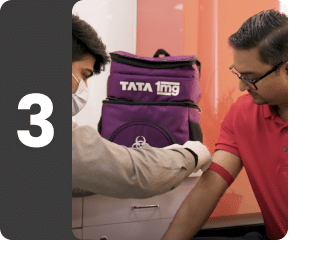Viral Respiratory Panel with HMPV
Understanding Viral Respiratory Panel with HMPV
What is Viral Respiratory Panel with HMPV?
The Viral Respiratory Panel with HMPV is a comprehensive molecular panel for qualitative detection of various respiratory viral pathogens, including human metapneumovirus (HMPV), human parainfluenza viruses, influenza A and B (including H1N1/swine flu and H3N2 subtypes), respiratory syncytial virus (RSV), and more responsible for respiratory infections such as the flu or the common cold, enabling precise identification of the underlying viral causes.
Viral respiratory infections are illnesses that can be mild, like a cold, or more serious, especially for young children, older adults, or people with weak immune systems. They are caused by different viruses like the flu, coronavirus, and others. These infections spread through droplets when someone coughs, sneezes, or talks, or by touching infected surfaces and then touching the face.
The Viral Respiratory Panel with HMPV checks for a wide range of viruses that cause respiratory illnesses. It uses advanced PCR technology to check for viruses like the flu, RSV, coronavirus, HMPV, parainfluenza, and more. The test also includes RNase P (IC), an internal control that ensures the accuracy and reliability of the results.
The Viral Respiratory Panel with HMPV is recommended when you have symptoms such as cough, sore throat, runny nose, nasal congestion, headache, and low-grade fever indicative of flu or a similar respiratory illness. It helps find the exact virus causing the illness, which allows for faster diagnosis and better treatment. This test is important during flu season or outbreaks, especially for those at higher risk, like young children, older adults, or people with weak immune systems. By detecting multiple viruses, this panel helps doctors quickly diagnose the cause of respiratory illnesses. It also helps differentiate viral infections sharing similar symptoms.
A positive result indicates that at least one or more of the respiratory virus strains is present in the sample. On the other hand, a negative result does not exclude the possibility of infection, as the results are dependent on appropriate specimen collection and other factors affecting PCR.
No special preparation is required for this test. Let the doctor know about any medicines or supplements being taken or about other health conditions, as they might affect the results.
Lab test results may vary across laboratories. Interpretation of the test results requires expert guidance. Therefore, do not self-medicate and talk to the doctor to understand the test results correctly.
What is Viral Respiratory Panel with HMPV used for?
The Viral Respiratory Panel with HMPV is done:
- To identify viral infections causing symptoms like fever, cough, sore throat, runny nose, or body aches.
- To diagnose infections caused by viruses such as HMPV, human parainfluenza virus (types 1-4), coronavirus, influenza A (including H1N1/swine flu and H3N2), influenza B, RSV, among others.
- To differentiate between the flu and other viral infections, ensuring precise diagnosis and treatment.
- To monitor the effectiveness of antiviral treatments or other therapeutic interventions.
What does Viral Respiratory Panel with HMPV measure?
Contains 18 testsThe Viral Respiratory Panel with HMPV tests for a wide variety of respiratory viruses to provide an in-depth understanding of respiratory health. It includes human metapneumovirus (A/B), which can cause illnesses ranging from mild cold symptoms to severe lung infections, especially in vulnerable populations. It also checks for the stains of human parechovirus and human coronavirus, both known to cause respiratory and gastrointestinal illnesses, and strains of human parainfluenza viruses (types 1, 2, 3, and 4), which are responsible for respiratory infections, including croup (infection of the vocal cords) and pneumonia. The panel also covers influenza A (including H3N2 and pandemic H1), influenza B and C, and enterovirus, all of which contribute to seasonal flu outbreaks. Additionally, it includes testing for human adenovirus, human respiratory syncytial virus (RSV), human rhinovirus, and human bocavirus, all of which are common causes of respiratory infections. Furthermore, RNASE P (IC) is included as an internal control to ensure the accuracy and reliability of the test results by verifying suitable conditions for precise RNA analysis.

Human Parechovirus
The Human Parechovirus test measures the presence of parechovirus RNA (genetic material) in a patient's sample, typically taken from the nose or throat swab. Parechovirus is a virus found in the respiratory and digestive systems, and it can cause mild to severe illnesses, particularly in infants, ranging from cold-like symptoms to more serious neurological or gastrointestinal issues. This test detects if the virus is present by converting any viral RNA into DNA through the RT-PCR process, followed by amplification to identify even small amounts of the virus. A positive result indicates an active parechovirus infection, while a negative result shows no virus was detected at the time of testing. It also aids in distinguishing enterovirus infections from other respiratory viruses that may present with similar symptoms, helping to prevent complications and ensuring proper diagnosis and treatment.
Know more about Human Parechovirus

Human Coronavirus
The Human Coronavirus test measures the presence of the genetic material (RNA) of the SARS-CoV-2 virus, which causes coronavirus (COVID-19) infection. The test works by collecting a sample, typically from the nose or throat, and using an RT PCR process to convert any viral RNA into DNA. This DNA is then amplified and analyzed to determine if the virus is present. A positive result indicates an active infection, while a negative result suggests the absence of the virus at the time of testing. It also helps distinguish Corona Virus infection from other respiratory illnesses causing similar symptoms, and guiding proper treatment. It is considered one of the most reliable methods for detecting COVID-19.
Know more about Human Coronavirus

Human Parainfluenza Virus 1
The Human Parainfluenza Virus 1 test measures the presence of genetic material (RNA) of the Human Parainfluenza Virus (HMPV) 1, a contagious virus that causes upper and lower respiratory illnesses, including croup, bronchitis, and pneumonia, particularly in young children and infants. The test requires a nasopharyngeal swab sample and uses Real-time PCR technology to detect the presence of the virus. A positive result indicates an active HPIV-1 infection, while a negative result shows no virus was detected at the time of testing. This test helps distinguish HPIV-1 infections from other viral respiratory illnesses, ensuring proper diagnosis and timely treatment to reduce the risk of complications.
Know more about Human Parainfluenza Virus 1

Human Parainfluenza Virus 2
The Human Parainfluenza Virus 2 test measures the presence of genetic material (RNA) of the Human Parainfluenza Virus (HPIV) 2, a contagious virus that causes upper and lower respiratory illnesses, including croup, bronchitis, and pneumonia, particularly in young children and infants. The test requires a nasopharyngeal swab sample and uses Real-time PCR technology to detect the presence of the virus. A positive result indicates an active HPIV-2 infection, while a negative result shows no virus was detected at the time of testing. This test helps distinguish HPIV-2 infections from other viral respiratory illnesses, ensuring proper diagnosis and timely treatment to reduce the risk of complications.
Know more about Human Parainfluenza Virus 2

Human Parainfluenza Virus 3
The Human Parainfluenza Virus 3 test measures the presence of genetic material (RNA) of the Human Parainfluenza Virus (HMPV) 3, a contagious virus that causes upper and lower respiratory illnesses, including croup, bronchitis, and pneumonia, particularly in young children and infants. The test requires a nasopharyngeal swab sample and uses Real-time PCR technology to detect the presence of the virus. A positive result indicates an active HPIV-3 infection, while a negative result shows no virus was detected at the time of testing. This test helps distinguish HPIV-3 infections from other viral respiratory illnesses, ensuring proper diagnosis and timely treatment to reduce the risk of complications.
Know more about Human Parainfluenza Virus 3

Human Parainfluenza Virus 4
The Human Parainfluenza Virus 4 test measures the presence of genetic material (RNA) of the Human Parainfluenza Virus (HMPV) 4. Although HPIV-4 infections are generally less common and less severe compared to other parainfluenza viruses, they can still contribute to upper and lower respiratory tract infections, particularly in young children, the elderly, or individuals with compromised immune systems. The test requires a nasopharyngeal swab sample and uses Real-time PCR technology to detect the presence of the virus. A positive result indicates an active HPIV-4 infection, while a negative result shows no virus was detected at the time of testing. This test helps distinguish HPIV-4 infections from other viral respiratory illnesses, ensuring proper diagnosis and timely treatment to reduce the risk of complications.
Know more about Human Parainfluenza Virus 4

Influenza A Virus
The Influenza A Virus test measures the presence of the Influenza A virus, a highly contagious virus that causes flu-like symptoms such as fever, cough, and body aches. This test detects viral RNA or antigens specific to Influenza A using nasopharyngeal swab sample, helping to diagnose infections and allowing for early treatment. It is useful for distinguishing influenza from other respiratory illnesses, guiding appropriate management, and preventing complications. The test is particularly valuable during flu season or when rapid diagnosis is needed to control the spread of the virus.
Know more about Influenza A Virus

Enterovirus
The Enterovirus detects the presence of enterovirus RNA (genetic material) in a patient's sample, often obtained from a nasal or throat. Enteroviruses can cause illnesses ranging from the common cold to more serious conditions like poliomyelitis and meningitis. The test works by converting entrovirus’s viral RNA into DNA through the RT PCR process. A positive result means the virus is present, while a negative result shows no virus was detected at the time of testing. It also aids in distinguishing enterovirus infections from other respiratory or neurological conditions that may present with similar symptoms, helping to prevent complications.
Know more about Enterovirus

Influenza A (H3N2) Virus
The Influenza A (H3N2) Virus test measures the presence of the H3N2 strain of the Influenza A virus in the body. This test detects the viral RNA or antigens specific to H3N2, which is one of the subtypes of Influenza A known to cause seasonal flu outbreaks. It helps identify if an individual is infected with the H3N2 virus, allowing for timely diagnosis and appropriate treatment. This test is important for distinguishing influenza from other respiratory illnesses and guiding healthcare providers in managing flu symptoms and reducing transmission.
Know more about Influenza A (H3N2) Virus

Human Metapneumoviruses (A/B)
The Human Metapneumoviruses (A/B) test measures the presence of RNA (genetic material) of human metapneumovirus (HPMV), a respiratory virus responsible for upper and lower respiratory tract infections, particularly in young children, adults over 65 and people with weakened immune systems. The test requires a nasopharyngeal swab sample and uses Real time-PCR technology to identify strains of HMPV A and HMPV B. A positive result indicates an active HMPV infection, while a negative result shows no virus was detected at the time of testing. The test also helps differentiate HMPV infections from other respiratory illnesses with similar symptoms, ensuring accurate diagnosis and timely treatment to prevent complications.
Know more about Human Metapneumoviruses (A/B)

Pandemic H1 Influenza Virus (pdm09)
The Pandemic H1 Influenza Virus (pdm09) test measures the presence of genetic material (RNA) of H1N1 influenza virus, responsible for causing flu-like symptoms, including fever, cough, and body aches, and can lead to more severe respiratory illnesses, especially in high-risk individuals. The test requires a nasopharyngeal swab sample and uses Real time-PCR technology to identify H1N1 infection. A positive result indicates an active H1N1 infection, while a negative result shows no virus was detected at the time of testing. This test also helps distinguish H1N1 infections from other respiratory viruses with similar symptoms, ensuring accurate diagnosis and appropriate treatment to reduce complications.
Know more about Pandemic H1 Influenza Virus (pdm09)

Influenza B Virus
The Influenza B Virus test measures the presence of genetic material (RNA) of the Influenza B virus, responsible for causing flu-like symptoms to more severe respiratory illnesses, particularly in high risk individuals (such as children or people with weakened immune systems). The test requires a nasopharyngeal swab sample and uses Real-time PCR technology to identify the Influenza B infection. A positive result indicates an active Influenza B infection, while a negative result shows no virus was detected at the time of testing. This test also helps differentiate Influenza B from other respiratory viruses with similar symptoms, ensuring an accurate diagnosis and guiding the appropriate treatment to reduce complications.
Know more about Influenza B Virus

Influenza C Virus
The Influenza C Virus test measures the presence of genetic material (RNA) of the Influenza C virus, which can cause mild respiratory symptoms, such as cough, sore throat, and low-grade fever. While Influenza C infections are generally less severe than those caused by Influenza A or B, they can still contribute to respiratory illness, particularly in vulnerable individuals. The test requires a nasopharyngeal swab sample and uses Real-time PCR technology to detect the Influenza C virus. A positive result indicates an active Influenza C infection, while a negative result shows no virus was detected at the time of testing. This test helps differentiate Influenza C from other respiratory viruses, ensuring accurate diagnosis and appropriate management of symptoms.
Know more about Influenza C Virus

Human Adenovirus
The Human Adenovirus test measures the presence of adenovirus RNA (genetic material) in patient's sample, usually collected from the nose or throat. This test uses the RT-PCR method to convert viral RNA into DNA, which is then amplified to detect even small amounts of the virus. A positive result indicates an active adenovirus infection, while a negative result means no virus was detected at the time of testing. The test helps identify adenovirus infections, which can cause symptoms similar to the common cold or more severe respiratory conditions such as pneumonia, especially in people with weakened immune systems or existing respiratory or cardiac disease. It also helps distinguish human adenovius infection from other respiratory illnesses, ensuring accurate diagnosis and proper treatment.
Know more about Human Adenovirus

Human Respiratory Syncytial
The Human Respiratory Syncytial, also known as RSV test measures the presence of RSV RNA (genetic material) in patient's sample, usually collected from the nose or throat. This test uses the RT-PCR method to convert viral RNA into DNA, which is then amplified to detect even small amounts of the virus. A positive result indicates an active RSV infection, while a negative result means no virus was detected at the time of testing. The test helps identify RSV infections, which can cause symptoms similar to the common cold or more severe respiratory conditions, especially in infants and the elderly. It also helps distinguish RSV from other respiratory infections, ensuring accurate diagnosis and proper treatment.
Know more about Human Respiratory Syncytial

Human Rhinovirus
The Human Rhinovirus test measures the presence of rhinovirus RNA (genetic material) in patient's sample, typically taken from the nose or throat. This test uses the RT-PCR method to convert Rhinovirus's RNA into DNA, which is then amplified to detect even small amounts of the virus. A positive result indicates an active rhinovirus infection, while a negative result means no virus was detected at the time of testing. The test helps identify rhinovirus infections, which are a common cause of the common cold, and can help distinguish them from other respiratory infections with similar symptoms, ensuring accurate diagnosis and appropriate treatment.
Know more about Human Rhinovirus
Human Bocavirus

RNASE P (IC)
The RNASE P (IC) test is used in the CDC (Centers for Disease Control and Prevention) protocol as an internal control (IC) for the detection of COVID-19, since this is a multi-copy gene that is abundant in the human genome, and therefore is easily detectable. Ribonuclease P (RNase P) is an endoribonuclease that cleaves other RNA molecules at the junction between a single-stranded region and the 5′ end of a double-stranded region. The enzyme is one of only two ribozymes that can be found in all kingdoms of life (Bacteria, Archaea, and Eukarya).
Know more about RNASE P (IC)
Frequently Asked Questions about Viral Respiratory Panel with HMPV
Q. What is the Viral Respiratory Panel with HMPV?
Q. When do I need this panel?
Q. How is the test performed?
Q. Is fasting required for this test?
Q. What happens if my results are positive?
Q. What happens if my test results are negative?
Q. Can this panel help with the flu season?
Q. Can I use this test for my child?
Q. How do viral respiratory infections spread?
Q. How can I prevent viral respiratory infections?
Q. Can I get a viral respiratory infection more than once in a season?
Q. How does Tata 1mg ensure accurate lab test results?
Book a Viral Respiratory Panel with HMPV test at home near me





Other tests









